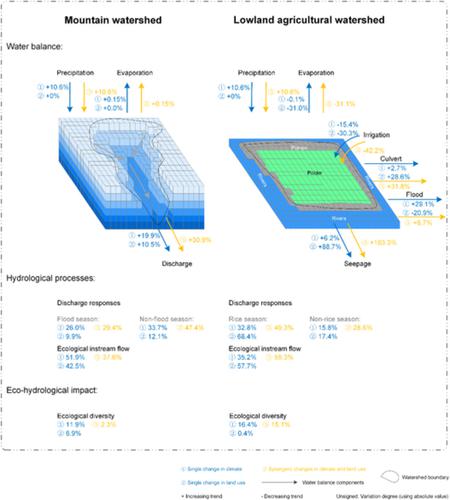当前位置:
X-MOL 学术
›
Hydrol. Process.
›
论文详情
Our official English website, www.x-mol.net, welcomes your feedback! (Note: you will need to create a separate account there.)
Quantifying the impacts of climate change and land use on hydrological processes: A comparison between mountain and lowland agricultural watersheds
Hydrological Processes ( IF 3.2 ) Pub Date : 2020-10-21 , DOI: 10.1002/hyp.13950 Zhen Cui 1, 2 , Jiacong Huang 1, 3 , Feng Tian 1, 2 , Junfeng Gao 1 , Xuesong Wang 4 , Jun Li 4
Hydrological Processes ( IF 3.2 ) Pub Date : 2020-10-21 , DOI: 10.1002/hyp.13950 Zhen Cui 1, 2 , Jiacong Huang 1, 3 , Feng Tian 1, 2 , Junfeng Gao 1 , Xuesong Wang 4 , Jun Li 4
Affiliation

|
Mountain and lowland watersheds are two distinct geographical units with considerably different hydrological processes. Understanding their hydrological processes in the context of future climate change and land use scenarios is important for water resource management. This study investigated hydrological processes and their driving factors and eco‐hydrological impacts for these two geographical units in the Xitiaoxi watershed, East China, and quantified their differences through hydrological modelling. Hydrological processes in 24 mountain watersheds and 143 lowland watersheds were simulated based on a raster‐based Xin'anjiang model and a Nitrogen Dynamic Polder (NDP) model, respectively. These two models were calibrated and validated with an acceptable performance (Nash‐Sutcliffe efficiency coefficients of 0.81 and 0.50, respectively) for simulating discharge for mountain watersheds and water level for lowland watersheds. Then, an Indicators of Hydrological Alteration (IHA) model was used to help quantify the alterations to the hydrological process and their resulting eco‐hydrological impacts. Based on the validated models, scenario analysis was conducted to evaluate the impacts of climate and land use changes on the hydrological processes. The simulation results revealed that (a) climate change would cause a larger increase in annual runoff than that under land use scenario in the mountain watersheds, with variations of 19.9 and 10.5% for the 2050s, respectively. (b) Land use change was more responsible for the streamflow increment than climate change in the lowland watersheds, causing an annual runoff to increase by 27.4 and 16.2% for the 2050s, respectively. (c) Land use can enhance the response of streamflow to the climatic variation. (d) The above‐mentioned hydrological variations were notable in flood and dry season in the mountain watersheds, and they were significant in rice season in the lowland watersheds. (e) Their resulting degradation of ecological diversity was more susceptible to future climate change in the two watersheds. This study demonstrated that mountain and lowland watersheds showed distinct differences in hydrological processes and their responses to climate and land use changes.
更新日期:2020-10-30


























 京公网安备 11010802027423号
京公网安备 11010802027423号